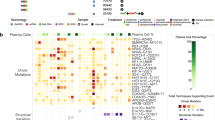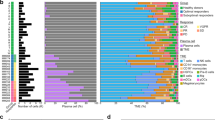Abstract
The Revised International Staging System (R-ISS) is a simple and powerful prognostic tool for multiple myeloma (MM). However, heterogeneity in R-ISS stage is still poorly characterised, hampering improvement of treatments. We used single-cell RNA-seq to examine novel cellular heterogeneity and regular networks in nine MM patients stratified by R-ISS. Plasma cells were clustered into nine groups (P1–P9) based on gene expression, where P1–P5 were almost enriched in stage III.PDIA6 was significantly upregulated in P3 and LETM1 was enriched in P1, and they were validated to be upregulated in the MM cell line and in 22 other patients’ myeloma cells. Furthermore, in progression, PDIA6 was newly found and verified to be activated by UQCRB through oxidative phosphorylation, while LETM1 was activated by STAT1 via the C-type lectin receptor-signalling pathway. Finally, a subcluster of monocytes was exclusively found in stage III specifically expressed chemokines modulated by ATF3. A few ligand-receptor pairs (CCL3/CCL5/CCL3L1-CCR1) were obviously active in monocyte-plasma communications in stage III. Herein, this study identified novel molecules, networks and crosstalk pairs in different R-ISS stages of MM, providing significant insight for its prognosis and treatment.
Similar content being viewed by others
References
Aibar, S., González-Blas, C.B., Moerman, T., Huynh-Thu, V.A., Imrichova, H., Hulselmans, G., Rambow, F., Marine, J.C., Geurts, P., Aerts, J., et al. (2017). SCENIC: single-cell regulatory network inference and clustering. Nat Methods 14, 1083–1086.
Botta, C., Di Martino, M.T., Ciliberto, D., Cucè, M., Correale, P., Rossi, M., Tagliaferri, P., and Tassone, P. (2016). A gene expression inflammatory signature specifically predicts multiple myeloma evolution and patients survival. Blood Cancer J 6, e511.
Cowan, A.J., Green, D.J., Kwok, M., Lee, S., Coffey, D.G., Holmberg, L. A., Tuazon, S., Gopal, A.K., and Libby, E.N. (2022). Diagnosis and management of multiple myeloma. JAMA 327, 464–477.
Efremova, M., Vento-Tormo, M., Teichmann, S.A., and Vento-Tormo, R. (2020). CellPhoneDB: inferring cell-cell communication from combined expression of multi-subunit ligand-receptor complexes. Nat Protoc 15, 1484–1506.
Flores-Montero, J., Sanoja-Flores, L., Paiva, B., Puig, N., García-Sánchez, O., Böttcher, S., van der Velden, V.H.J., Pérez-Morán, J.J., Vidriales, M. B., García-Sanz, R., et al. (2017). Next Generation Flow for highly sensitive and standardized detection of minimal residual disease in multiple myeloma. Leukemia 31, 2094–2103.
Gringhuis, S.I., den Dunnen, J., Litjens, M., van Het Hof, B., van Kooyk, Y., and Geijtenbeek, T.B.H. (2007). C-type lectin DC-SIGN modulates Toll-like receptor signaling via Raf-1 kinase-dependent acetylation of transcription factor NF-κB. Immunity 26, 605–616.
Harnoss, J.M., Le Thomas, A., Shemorry, A., Marsters, S.A., Lawrence, D. A., Lu, M., Chen, Y.C.A., Qing, J., Totpal, K., Kan, D., et al. (2019). Disruption of IRE1α through its kinase domain attenuates multiple myeloma. Proc Natl Acad Sci USA 116, 16420–16429.
Jang, J.S., Li, Y., Mitra, A.K., Bi, L., Abyzov, A., van Wijnen, A.J., Baughn, L.B., Van Ness, B., Rajkumar, V., Kumar, S., et al. (2019). Molecular signatures of multiple myeloma progression through single cell RNA-Seq. Blood Cancer J 9, 2.
Kouno, J., Nagai, H., Nagahata, T., Onda, M., Yamaguchi, H., Adachi, K., Takahashi, H., Teramoto, A., and Emi, M. (2004). Up-regulation of CC chemokine, CCL3L1, and receptors, CCR3, CCR5 in human glioblastoma that promotes cell growth. J Neurooncol 70, 301–307.
Li, Y.L., Chen, C.H., Chen, J.Y., Lai, Y.S., Wang, S.C., Jiang, S.S., and Hung, W.C. (2020). Single-cell analysis reveals immune modulation and metabolic switch in tumor-draining lymph nodes. OncoImmunology 9, 1830513.
Morrissey, M.A., Kern, N., and Vale, R.D. (2020). CD47 ligation repositions the inhibitory receptor SIRPA to suppress integrin activation and phagocytosis. Immunity 53, 290–302.e6.
Olkhov-Mitsel, E., Hodgson, A., Liu, S.K., Vesprini, D., Bayani, J., Bartlett, J., Xu, B., and Downes, M.R. (2021). Immune gene expression profiles in high-grade urothelial carcinoma of the bladder: a NanoString study. J Clin Pathol 74, 53–57.
Palumbo, A., Avet-Loiseau, H., Oliva, S., Lokhorst, H.M., Goldschmidt, H., Rosinol, L., Richardson, P., Caltagirone, S., Lahuerta, J.J., Facon, T., et al. (2015). Revised international staging system for multiple myeloma: a report from International Myeloma Working Group. J Clin Oncol 33, 2863–2869.
Rajkumar, S.V. (2016). Multiple myeloma: 2016 update on diagnosis, risk-stratification, and management. Am J Hematol 91, 719–734.
Rajkumar, S.V., and Kumar, S. (2016). Multiple myeloma: diagnosis and treatment. Mayo Clin Proc 91, 101–119.
Ri, M. (2016). Endoplasmic-reticulum stress pathway-associated mechanisms of action of proteasome inhibitors in multiple myeloma. Int J Hematol 104, 273–280.
Shi, H., Han, X., Sun, Y., Shang, C., Wei, M., Ba, X., and Zeng, X. (2018). Chemokine (C-X-C motif) ligand 1 and CXCL2 produced by tumor promote the generation of monocytic myeloid-derived suppressor cells. Cancer Sci 109, 3826–3839.
Shin, Y.K., Jang, S.Y., Lee, H.K., Jung, J., Suh, D.J., Seo, S.Y., and Park, H. T. (2010). Pathological adaptive responses of Schwann cells to endoplasmic reticulum stress in bortezomib-induced peripheral neuropathy. Glia 58, 1961–1976.
Shu, M., Xue, X., Nie, H., Wu, X., Sun, M., Qiao, L., Li, X., Xu, B., Xiao, Z., Zhao, Y., et al. (2022). Single-cell RNA sequencing reveals Nestin+ active neural stem cells outside the central canal after spinal cord injury. Sci China Life Sci 65, 295–308.
Storti, P., Vescovini, R., Costa, F., Marchica, V., Toscani, D., Dalla Palma, B., Craviotto, L., Malavasi, F., and Giuliani, N. (2020). CD14+ CD16+ monocytes are involved in daratumumab-mediated myeloma cells killing and in anti-CD47 therapeutic strategy. Br J Haematol 190, 430–436.
Svachova, H., Kryukov, F., Kryukova, E., Sevcikova, S., Nemec, P., Greslikova, H., Rihova, L., Kubiczkova, L., and Hajek, R. (2014). Nestin expression throughout multistep pathogenesis of multiple myeloma. Br J Haematol 164, 701–709.
Tamai, S., Iida, H., Yokota, S., Sayano, T., Kiguchiya, S., Ishihara, N., Hayashi, J.I., Mihara, K., and Oka, T. (2008). Characterization of the mitochondrial protein LETM1, which maintains the mitochondrial tubular shapes and interacts with the AAA-ATPase BCS1L. J Cell Sci 121, 2588–2600.
Trapnell, C., Cacchiarelli, D., Grimsby, J., Pokharel, P., Li, S., Morse, M., Lennon, N.J., Livak, K.J., Mikkelsen, T.S., and Rinn, J.L. (2014). The dynamics and regulators of cell fate decisions are revealed by pseudotemporal ordering of single cells. Nat Biotechnol 32, 381–386.
Vallet, S., and Anderson, K.C. (2011). CCR1 as a target for multiple myeloma. Expert Opin Ther Targets 15, 1037–1047.
Vogelstein, B., Papadopoulos, N., Velculescu, V.E., Zhou, S., Diaz, L.A., and Kinzler, K.W. (2013). Cancer genome landscapes. Science 339, 1546–1558.
Wang, L., Yin, J., Wang, X., Shao, M., Duan, F., Wu, W., Peng, P., Jin, J., Tang, Y., Ruan, Y., et al. (2016). C-type lectin-like receptor 2 suppresses AKT signaling and invasive activities of gastric cancer cells by blocking expression of phosphoinositide 3-kinase subunits. Gastroenterology 150, 1183–1195.e16.
Wevers, B.A., Kaptein, T.M., Zijlstra-Willems, E.M., Theelen, B., Boekhout, T., Geijtenbeek, T.B.H., and Gringhuis, S.I. (2014). Fungal engagement of the C-type lectin mincle suppresses dectin-1-induced antifungal immunity. Cell Host Microbe 15, 494–505.
Xiao, G., Lundine, D., Annor, G.K., Canar, J., Ellison, V., Polotskaia, A., Donabedian, P.L., Reiner, T., Khramtsova, G.F., Olopade, O.I., et al. (2020). Gain-of-function mutant p53 R273H interacts with replicating DNA and PARP1 in breast cancer. Cancer Res 80, 394–405.
Zhang, H., Ye, Y.L., Li, M.X., Ye, S.B., Huang, W.R., Cai, T.T., He, J., Peng, J.Y., Duan, T.H., Cui, J., et al. (2011). CXCL2/MIF-CXCR2 signaling promotes the recruitment of myeloid-derived suppressor cells and is correlated with prognosis in bladder cancer. Oncogene 36, 2095–2104.
Zhang, Y., Lv, K., Zhang, C.M., Jin, B.Q., Zhuang, R., and Ding, Y. (2014). The role of LAIR-1 (CD305) in T cells and monocytes/macrophages in patients with rheumatoid arthritis. Cell Immunol 287, 46–52.
Acknowledgements
This work was supported by the National Natural Science Foundation of China (82002212, 81870683, 82070928, 81790643, 82121003), the Science & Technology Department of Sichuan Province (19YJ0593, 2020ZYD035, 2020YJ0460, 2020JDTD0028, 2021JDGD0036, 2021YFS0404, 2021YFS0369, 2022JDTD0024), Department of Sichuan Provincial Health (19PJ117), the Sichuan Provincial People’s Hospital (2018LY03), the Chengdu Science and Technology Bureau (2019-YF05-00572-SN), the China Postdoctoral Science Foundation Grant (2019M663567), the foundation of Basic Scientific Research in Central Universities of University of Electronic Science and Technology (ZYGX2020J024), Medicine-engineering interdisciplinary grant of University of Electronic Science and Technology (ZYGX2021YGLH006), the CAMS Innovation Fund for Medical Sciences (2019-12M-5-032). We thank all the patients and their families for participating in this study. We thank OE Biotech Co., Ltd (Shanghai, China) for providing single-cell RNA-seq, YaoLu, Yongbing Ba and Tingjing Gong for assistance with bioinformatics analysis.
Author information
Authors and Affiliations
Corresponding authors
Additional information
Compliance and ethics
The author(s) declare that they have no conflict of interest.
Rights and permissions
About this article
Cite this article
Zhong, L., Yang, X., Zhou, Y. et al. Exploring the R-ISS stage-specific regular networks in the progression of multiple myeloma at single-cell resolution. Sci. China Life Sci. 65, 1811–1823 (2022). https://doi.org/10.1007/s11427-021-2097-1
Received:
Accepted:
Published:
Issue Date:
DOI: https://doi.org/10.1007/s11427-021-2097-1




